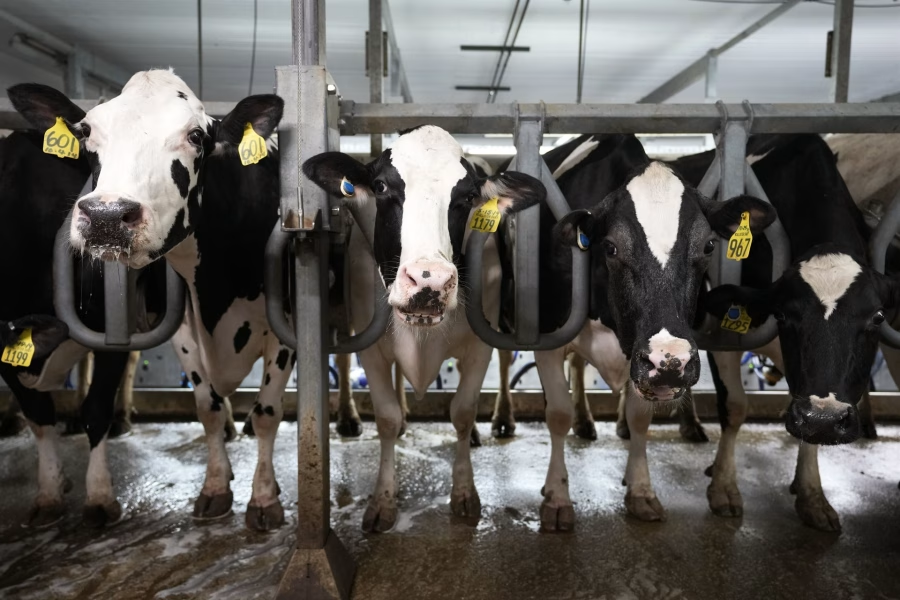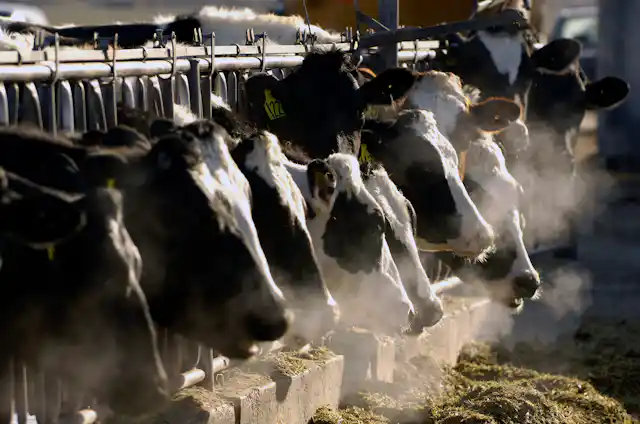Stay updated on Iowa’s avian flu crisis: 13 infections reported among dairy herds and poultry flocks this June. What are the ramifications for local agriculture and the implementation of new safety protocols?

A concerning avian flu epidemic in Iowa affects dairy cows and chicken flocks. Along with incidences in Sac, Plymouth, Cherokee, and O’Brien counties, Sioux County could be better struck, with 12 dairy farms and one poultry flock afflicted. While the USDA has started voluntary avian flu testing in bulk milk tanks across many states, this issue has prompted the Iowa Department of Agriculture and Land Stewardship to develop new rules. Maintaining Iowa’s crucial agricultural economy depends on controlling the epidemic.
Sioux County, Dairy Industry Faces Intensified Struggles Amid Avian Flu Surge
Two more bird flu cases surfaced in dairy cows in Sioux County, aggravating the county’s already tricky fight with the disease. Around 980 animals are in one herd, and 2,500 are in another. These fresh diseases have seriously affected the county’s dairy sector, adding to the 13 June outbreaks previously registered.
The virus has affected twelve dairy farms and one poultry flock in Sioux County, with significant implications for the dairy sector. This underscores the urgent need for solid biosecurity policies to prevent further outbreaks and protect those reliant on the dairy sector.
Sioux County Reels from Avian Flu’s Indiscriminate Assault on Dairy and Poultry Operations
With twelve compromised dairy herds, Sioux County is reeling from the indiscriminate spread of the avian flu epidemic. The herds, ranging from small with around 45 cows to large enterprises with up to 10,000 cows, demonstrate the virus’s widespread impact on small and large-scale dairy farms.
The county also recorded poultry diseases, including a commercial egg-laying chicken farm of about 4.2 million birds. This double effect on dairy and poultry emphasizes the widespread avian flu in Sioux County, posing significant difficulties for local producers and stressing the necessity of immediate containment strategies.
Disparate Impact of Avian Influenza on Dairy Cattle and Poultry Necessitates Species-Specific Biosecurity Measures
Bird flu, or avian influenza, affects species differently. Usually showing mild to severe symptoms, dairy cows recover in two weeks. By contrast, the virus almost invariably kills poultry, which results in high death rates and the mass slaughter of whole flocks meant to stop transmission. This variation emphasizes the need for particular biosecurity policies for various animals to reduce the effect of avian influenza.
USDA’s Proactive Measures and FDA’s Recommendations: Ensuring Dairy Safety Amid Avian Flu Outbreaks
The USDA has started a voluntary testing program for bird flu in bulk milk tanks in Nebraska, Kansas, New Mexico, and Texas in response to the concern about the spread of avian influenza. This proactive approach promotes a more all-encompassing virus surveillance and control strategy within dairy operations.
At the same time, the FDA stresses the dangers of drinking raw milk. Understanding how dangerous avian flu is, the FDA emphasizes that pasteurization completely removes the virus, guaranteeing milk safety. To protect their health, consumers are advised not to drink raw milk.
Statewide Proliferation of Avian Flu: Beyond Sioux County, Multiple Iowa Counties Battle Escalating Infections
Apart from Sioux County, the avian flu epidemic has also touched Sac, Plymouth, Cherokee, and O’Brien counties. Sac County had instances in commercial turkey flocks; Plymouth and Cherokee reported illnesses in dairy cows and turkeys, respectively. O’Brien County has also battled instances involving dairy farms. These events emphasize the broad scope of the epidemic and support the need for strict biosecurity policies throughout Iowa.
- June 2: A commercial turkey flock in Cherokee County with about 103,000 birds.
- June 5: A dairy herd in O’Brien County with about 4,500 cattle.
- June 7: A dairy herd in Sioux County with about 250 cattle.
- June 12: A dairy herd in Sioux County with about 1,700 cattle.
- June 14: A dairy herd in Plymouth County with about 3,000 cattle.
- June 14: A dairy herd in Sioux County with about 1,000 cattle.
- June 15: A dairy herd in Sioux County with about 520 cattle.
- June 17: A dairy herd in Sioux County with about 10,000 cattle.
- June 19: A dairy herd in Sioux County with about 100 cattle.
- June 20: A commercial turkey flock in Sac County with about 46,000 birds.
- June 21: A dairy herd in Sioux County with about 500 cattle.
- June 21: A dairy herd in Sioux County with about 45 cattle.
- June 24: A dairy herd in Sioux County with about 5,000 cattle.
- June 27: A dairy herd in Sioux County with about 980 cattle.
- June 27: A dairy herd in Sioux County with about 2,500 cattle.
The Bottom Line
The fresh increase in avian flu cases in Iowa, particularly in Sioux County, emphasizes how urgently improved biosecurity and careful monitoring in dairy and chicken farms are needed. With 13 instances in June alone, the virus has seriously affected local dairy farms and destroyed poultry flocks, necessitating culling to stop its spread.
Necessary steps for containment include state and federal actions, including new regulations for dairy cow exhibits by the Iowa Department of Agriculture and bulk milk tank testing. Still, public awareness and rigorous biosecurity policies will help to support these and avoid further epidemics.
With illnesses recorded in Sac, Plymouth, Cherokee, and O’Brien counties, Sioux County’s predicament mirrors a more general statewide concern. This calls for a coordinated, statewide approach to address the rising avian flu danger adequately.
Along with regulatory authorities and the public, the dairy and poultry sectors depend on each other to cooperate in applying rigorous preventative actions. Avian flu is a nasty disease, so a quick and continuous response is needed. Consumers should avoid raw milk and follow safety recommendations.
Overall, Iowa’s war against avian flu is still ongoing. Authorities, business players, and society must remain dedicated and aggressive. This will help us maintain public health, guarantee the existence of agricultural sectors, and protect our animals. The message is clear: improve biosecurity, respect rules, and assist initiatives against avian flu.
Key Takeaways:
- Sioux County alone has reported 12 infected dairy herds and one infected chicken flock, contributing significantly to Iowa’s total of 13 reports of bird flu in dairy cattle herds for June.
- The most recent cases involve a 980-cow herd and one with 2,500 cattle, indicating the widespread and indiscriminate nature of the virus.
- Poultry remains particularly vulnerable, with entire flocks often being culled to prevent further spread, unlike cattle, which generally recover from avian flu within two weeks.
- In response, the Iowa Department of Agriculture and Land Stewardship has implemented new rules for dairy cattle exhibitions to curb the virus’s spread.
- The USDA has announced voluntary testing for bird flu in bulk milk tanks at dairies in four additional states—Nebraska, Kansas, New Mexico, and Texas—to bolster preventive measures.
- Beyond Sioux County, infections have been confirmed in Sac, Plymouth, Cherokee, and O’Brien counties, demonstrating the virus’s rapidly expanding footprint within Iowa.
- Pasteurization is effective in killing the avian flu virus, and the FDA advises avoiding raw milk to reduce the risk of infection.
Summary:
The avian flu epidemic in Iowa is causing significant challenges for the dairy and poultry sectors, with 12 dairy farms and one poultry flock affected. The outbreak has been exacerbated by bird flu cases in Sioux County, which has 12 compromised dairy herds and a commercial egg-laying chicken farm of about 4.2 million birds. The virus affects different species differently, with dairy cows recovering in two weeks and poultry almost invariably killing them, leading to high death rates and mass slaughter of whole flocks. This highlights the need for specific biosecurity policies for various animals to reduce the impact of avian influenza. The USDA has initiated voluntary testing programs for bird flu in bulk milk tanks in Nebraska, Kansas, New Mexico, and Texas to promote comprehensive virus surveillance and control. A coordinated, statewide approach is needed to address the rising avian flu danger, and consumers should avoid raw milk and follow safety recommendations. Iowa’s war against avian flu is ongoing, and authorities, business players, and society must remain dedicated and aggressive to maintain public health, ensure agricultural sectors, and protect animals.












